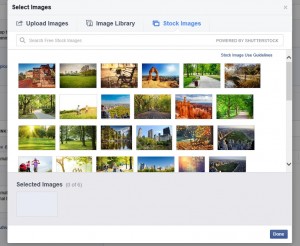These days Facebook makes it hard to get exposure for anything on the platform unless you put some dollars behind it. If you haven’t noticed that your organic Facebook Page posts are getting fewer and fewer impressions and engagements, then you’re either asleep at the wheel, or you’re lucky enough to have super ultra-engaged fans. Instead of sitting around crying over Zucker’s total selfishness and greed, it may be better to suck it up and put some money behind your marketing, which is generally what you have to do on most other marketing channels to get exposure anyway.
Facebook ad campaigns can be pretty simple to put together – you certainly don’t need an agency (charging $200+ an hour) to do it for you. However, there are a few little tips and tricks that can help you get the most bang for your buck when it comes to Facebook advertising. Back in 2012, I posted an article on 10 ways to optimize your Facebook ads, but times have changed since then, and so have Facebook’s ad platforms. And so, an update is required! Behold – the tips:
1. Test multiple images
When it comes to any digital marketing that can be tracked/measured (which should be pretty much all digital marketing), it’s always a good idea to test. Even the most seasoned marketer never truly knows what creative will resonate best with their target market until they run some testing. The best thing about the Facebook advertising platform is that it optimizes your ad campaign for you – taking all your ad variations, testing them and continuing to display only the best-performing ones. Each Ad set you create allows you to use up to six different images – use them. Think outside the box and try some different images that relate to whatever you are promoting (your business, an event, a sale etc) so you can learn which images will attract the best results. You can definitely test your logo as one, but it’s a good idea to try some more lifestyle-based shots as well. Facebook will optimize the campaign based on your key objective (be it likes, clicks, responses etc). Another cool feature – you can search for free stock images in a huge library thanks to Shutterstock, so you don’t even need to have your own images handy.

2. Make sure your images are optimal sizes
Some Facebook ad types allow you to utilize both the news feed and the right-hand ad column for your campaign. The caveat is that these have two different optimal sizes for the image used. The News Feed images are recommended to be 600px x 225px, while the right-hand side images are best sized at 100px x 72px. If you try and use the same image for both (as Facebook prompts you to do), then one format may not appear as optimal as it would otherwise have looked. In order to prevent this, I sometimes create two separate ad campaigns – one for the ads on the right-hand side column and one for the news feed ads. This way, you can ensure the best images are used for both. Before you do this, check what the images look like in the mock-up that Facebook provides – if it looks fine to use the same image for both, then don’t worry about splitting it into another ad set. If you need to split them, this means that Facebook can’t automatically optimize one or the other out of the campaign based on comparison performance. Instead, you have to keep a manual eye on the performance of both and decide for yourself if you want to switch one off if the other is performing significantly better.
3. Test Headlines and copy
As with images, it’s also a good idea to test headlines and copy to determine what results in the best cost per action. You might want to test having your brand name as the title, a question, or a call-to-action. I typically recommend you end the copy with some sort of call to action – like buy now! Register today! Learn More! Etc. Test the same headline/copy variations across all your different images so that you can accurately ascertain what combination works best.
 4. Target where it makes sense
4. Target where it makes sense
I’m a firm believer that sometimes we can go a little overboard where targeting is concerned. And Facebook makes that easy to do, with many options to choose from in terms of audience segmentation. You can target by location, age, gender, language, relationship status, workplace, school, education level, interests, job status, mobile OS, whether they have a birthday in a week, have just gotten a new job, have recently moved and more. The options here are almost boundless. Targeting is a great idea if you have a very good idea about your target audience, have a limited budget and want to make sure you get the most from it. You should also always target by location if your business is restricted by geography (i.e. if you’re not a global business). However, if you have a fairly broad target audience, sometimes you can restrict yourself too much by going crazy with targeting. Facebook displays the total number of people you can possibly reach based on your targeting options, so just keep this in mind and make sure it’s not too small.
5. Trial re-targeting ads to convert your past visitors
You may or may not be aware that you can even do this, but an awesome feature of Facebook advertising is the ability to re-target people who have previously visited your site. Sometimes this can be to an impressively granular level – for example, Tripadvisor often promotes hotels I have looked at back to me on Facebook ads, and I’ve also seen Virgin Australia prompt me to book a flight to New York or Auckland because I’ve been looking at those particular routes on their website previously. This obviously involves a little more than standard Facebook advertising, as a tracking tag needs to be added to your website code, but it’s well worth testing out. There are a number of businesses that are experts in this, including Perfect Audience, which also offers a free $70 trial to get started. It’s relatively painless and fast to set up, so if you haven’t investigated this before, I strongly recommend it!
6. Incorporate Sponsored Stories into your campaign
In my experience, Sponsored Stories are almost always the best-performing element of any Facebook ad campaign driving likes of a Page. I recommend making sure you always tick the box, including this in your ad campaign. Sponsored Stories are basically little adverts that notify people that their friend has liked your page and prompt them to do so as well. This is obviously leveraging a peer recommendation rather than just a sponsored message from your business and hence tends to work much more effectively to get likes for your Page. Including this in your ad campaign does not require any extra spending (though every response to a sponsored story will cost money out of the total campaign budget).
7. Put dollars behind sponsored posts
Another thing I generally always recommend for tactical campaigns is to put money behind sponsored posts on your Page. This means ‘boosting’ a post you write so that not only more of your fans will see it but also that their Facebook friends may also see the post. You can also target the same sort of segments via sponsored posts as you can with ads. This is a handy way to get more exposure for a particular event or update and also for your business/Page in general. Boosting a post doesn’t require a large budget – you can usually do so for as little as about $6 – and Facebook will let you know the approximate reach for your total spend.
8. Identify your objectives and split campaigns where necessary
As I’ve already touched on in some of the amazingly helpful advice above, Facebook very effectively (and sometimes a little over-zealously) optimizes your Facebook campaign on your behalf. This means that if you put a lot of ad creative variations into one advert set, you may see that Facebook will stop serving most of those variations altogether in favor of one or two that are out-performing the others. This is usually helpful, but sometimes, there may be a particular ad that you want to keep displaying to your audience, even if it is attracting a worse cost per action than others. This was more important just a few weeks ago before Facebook changed their ad platform (again), as you may have had all different ad types within one ad set – but it still may be relevant now. Basically, if you find this is happening, you need to split your advert set so that you have a secondary campaign under the overarching campaign (I can see this is getting a little confusing, but hopefully still makes some sense). Facebook will only optimize ad variations within the same advert set – not across advert sets within the same campaign. Make sure the ads that you want to be gaining airplay are getting the chance to do so by keeping an eye on this and splitting ads out to another advert set if need be.
 9. Get help from experts
9. Get help from experts
Facebook advertising isn’t hard to set up via the Facebook Adverts Manager. However, if you’re going to put your precious marketing dollars to work, sometimes you do want to make sure you’re getting the best results for your spend. Facebook advertising can also be a little time-consuming, particularly if you have various objectives (e.g., likes, website visits, event responses etc) you would like to achieve or test. If you want to get help with your Facebook campaign, get in touch with me, and I will try and provide some advice and/or provide a quote for executing the campaign for you. If you have a budget above $1.5k, I can also get you direct access to the Facebook Marketing Team in Facebook, who will provide ongoing advice to actively optimize your campaign and make sure you achieve your goals. Get in touch with me about this here.
So those are my key pointers in order to get the best bang for your Facebook ad buck. Have you seen much success from your Facebook ad campaigns in the past? Do you have any other advice you can share? Share it in the comments section if you do!
